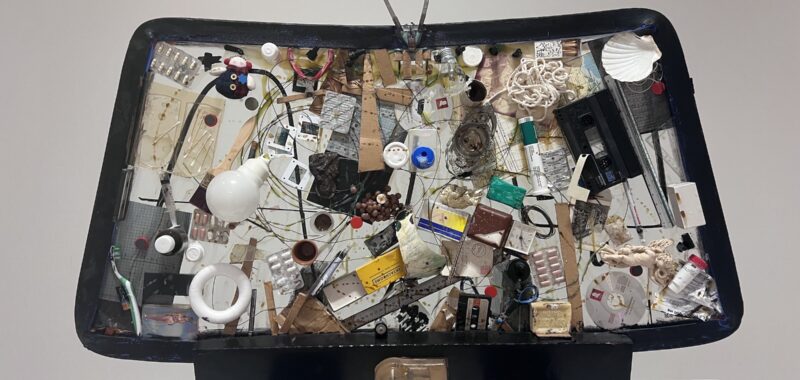
In a room thick with memory, there is a thing — that’s the closest word I have for it — irradiated by late afternoon light. Before your eyes, it toggles between meaning and pointlessness, resembling, by turns, a rocking horse-like toy set atop a glimmering metallic ocean of plastic wrappers, like a chariot riding toward salvation, and a municipal-orange tossaway randomly placed on a heap of other nothings. Not a symbol, simply evidence that something destructive occurred.
Ser Serpas’s objects, which fill the first room, set the tone and tempo for The Gatherers, an exhibition of 14 international artists that deal in garbage and surplus, waste and excess, at MoMA PS1 — a museum in a former public school building in one of the most rapidly developing parts of the borough and city. It draws our attention to a rising aesthetic of construction, destruction, and the palimpsests left by the too-quick cycling between the two. It sets up human production — not as individuals, nor as small groups, as an emergent property of our global collectivity — as a force of new sublimity, as powerful in contemporary art as nature was to the Romantics.

The most common strategy in this exhibition is to reframe the detritus of capitalism as formally interesting. Bosnian artist Selma Selman, for instance, presents an industrial nail gilded with gold extracted from motherboards scrapped by her family’s metal recycling business (“Nail,” 2025) and a construction claw repurposed as a blossom that opens and closes with a loud, grinding noise (“Flowers of Life,” 2025). Klara Liden’s “Untitled (Membrane 5)” (2025) is a slab of roofing material that looks every bit like an intentional work of abstraction. British artist’s Nick Relph’s dye sublimation aluminum prints consist of 1:1 reproductions of city surfaces and signages, locating art in overlooked niches of the city.
It’s Georgian artist Tolia Astakhishvili who most successfully gestures to the sublimity of human overproduction, doing so via a mechanics of exhaustion. In Astakhishvili and David Perice’s two-channel video “so many things I’d like to tell you” (2025), objects like a crushed coke can, a spoon, and a packet of pills pass through a scanner. These familiar objects, made uncanny in this clinical context, as if sourced from an archaeological dig in the future, are interesting at first; then the attention flags. It’s the difference between being directed toward a particularly witty piece of subway graffiti and being asked to examine every tile in a station.
These strategies — drawing attention to the formal qualities of that which we’ve collectively authored in the form of overproduction, and to the impossibility of really grasping the vastness of overproduction as individuals — make for an interesting exhibition, but I’m not convinced that it’s enough to actually sustain an artistic movement. Even in this context, certain strategies, effective at first, began to feel either repetitive or thin, such as video art as a tool to express deep time. Somewhat counterintuitively, it’s a work in possibly the most primitive media here — painting — that felt among the most effective. Samuel Hindolo’s “Gare de Bruxelles-Nord” (2024) is de Chirico-like in its almost hieroglyphic compositional clarity. In its delirious juxtaposition of familiar elements — sphinx, staircase, sky — it destabilizes in ways impossible and familiar.





plywood

The Gatherers continues at MoMA PS1 (22-25 Jackson Avenue, Queens, New York) through October 6. The exhibition was curated by Ruba Katrib with Sheldon Gooch and Serena Moscardelli.

